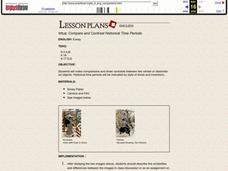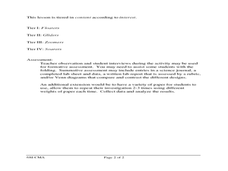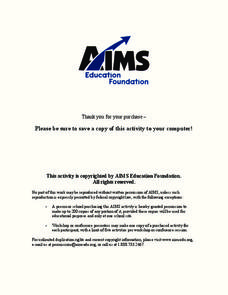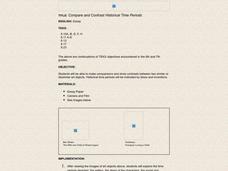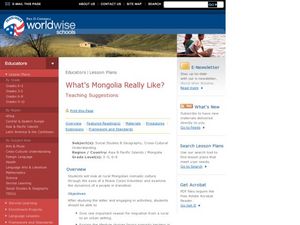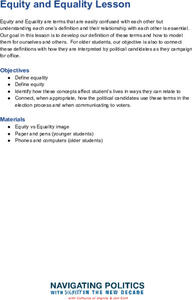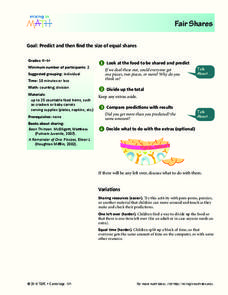Curated OER
Compare and Contrast Historical Time Periods
What do images tell us about history? Dress, setting, and actions all convey cultural norms, and in essence, give reference to historical time and place. Learners compare and contrast Kunisada's Actor with Flute in Snow to Hokuei's...
Digital Public Library of America
Teaching Guide: Exploring Little Women
Louisa May Alcott's Little Women is a literary masterpiece as well as a timestamp of the formative mid-nineteenth century in America. Using a primary source set of photographs, letters, and portraits, readers discuss the ways...
Curated OER
Origami Flight: The Physical Setting
Sixth graders investigate the forces that move certain objects. In this physics lesson, 6th graders design and create paper flying objects using origami methods, which they practice flying in different conditions. Students...
Curated OER
Goal Setting: Respect for ALL Workers
Students discuss their views on the importance of various jobs. In this career paths and goal-setting lesson, students create a list of all jobs required to produce a particular object. Students then prioritize the importance of...
ProCon
Minimum Wage
The first ever minimum wage in America was set at 25 cents per hour in 1938 and has been steadily, if slowly, increasing ever since. Using the provided website, pupils decide if the United States should further increase the federal...
Curated OER
Bears Wear Buttons
Students practice counting sets of objects and numerals. In this numerical identification lesson, students listen to the story, Bears Wears Buttons, and participate in a flash card activity where students must place buttons on...
Curated OER
Region Reality
Eighth graders compare and contrast world regions and explore the theme of world regions. In this world geography instructional activity, 8th graders name regions in the U.S. and mark them on a map. Students discuss the cultural and...
Curated OER
Comparing Matter
Pupils use Internet to research and discover states of matter and explain how molecules are arranged in each state, complete Comparing Matter Work Sheet, and identify objects around classroom that fit three states of matter definitions.
Curated OER
COMPARE AND CONTRAST HISTORICAL TIME PERIODS
Young scholars make comparisons and show contrasts between two similar or dissimilar art objects. Historical time periods will be indicated by dress and inventions.
Curated OER
Introduction to Primary Sources
Young scholars explore the usage of primary sources, what they are and how they originate. Artifacts are compared and contrasted as part of this historical inquiry as questions are formulated and conclusions drawn.
Curated OER
Using a Graphic Organizer to Critically Observe Televised News Broadcasts
Students compare two television news broadcasts. They discuss how to organize information when comparing two objects and read and discuss two books to create a Venn diagram to compare both books. After creating the diagram, they view...
NASA
Space-Based Astronomy on the Internet
Young scientists compile everything they have learned into a report in the fifth and final lesson in a unit on the visible light spectrum. Access to photos from observatories, telescopes, and satellites allows learners to compare...
Curated OER
What's Mongolia Really Like?
Students discover the people of Mongolia. In this social studies lesson, students look at the Mongolian nomadic culture by reading a letter written by a member of the Peace Corps. They describe the different types of communities found in...
Cultures of Dignity
Equity and Equality Lesson
Equality does not equal equity and this lesson explains why. Class members compare two images--one labeled "Equality" and the other "Equity." Using the provided discussion questions, they then develop definitions that distinguish between...
Curated OER
The Touch N Feel Box
Students discover the characteristics of living and non living objects without the use of sight. In this sense of touch lesson, students touch items put in a shoe box and must identify whether the item was once living or not by...
Curated OER
If a Runner Runs, Does a Sweater Sweat?
Play with words and word meanings involving the suffix -er. After reading a sample list of words, young readers look up each one in the dictionary to decide which words refer to people, animals, or objects, or have three or more...
Curated OER
Comparing News Sources: Where Would You Turn?
Students follow the study of Ray Bradbury's Fahrenheit 451 and attempts to connect the thematic underpinnings of the novel to Students' own lives.
Curated OER
Greek and Roman Myths in Art-A Set of 7 Activities
Students paricipate in seven activities to investigate ancient stories about heroes, monsters, gods, and goddesses.
Curated OER
Measurements Around the Classroom
Third graders practice measuring items by examining classroom objects. In this geometry lesson plan, 3rd graders utilize measuring tools to find the weight, time, length or temperature of specific classroom items. Students...
Curated OER
Patterns & Balance
Students compare and contrast the difference in the two sets of images and discuss the visual interest in the first set and the different visual interest created in the second set of prints.
Curated OER
What is the Evidence for Evolution?
Students identify one object that would tell the story of their lives. In groups, they determine what can and cannot be told from objects left behind. After watching a video, they compare and contrast chicken bones to human bones. To...
Curated OER
Trade and Travel Along the Silk Road
Students examine the religions that developed along the Silk Road. In this compare and contrast lesson, students visit various stations within the classroom to learn about the Silk Road and the two religions that developed. Using a...
Curated OER
Fair Shares
Learners investigate division by sharing food items with their classmates. In this division lesson, students are given a food item which they must equally share among the class using division. Learners predict how many...
American Museum of Natural History
Trip Up Your Brain
Sometimes different parts of the brain disagree. See what this disagreement looks like using a remote learning resource to experience how brains often take shortcuts. Pupils complete the activity, observe their results, and then read...
